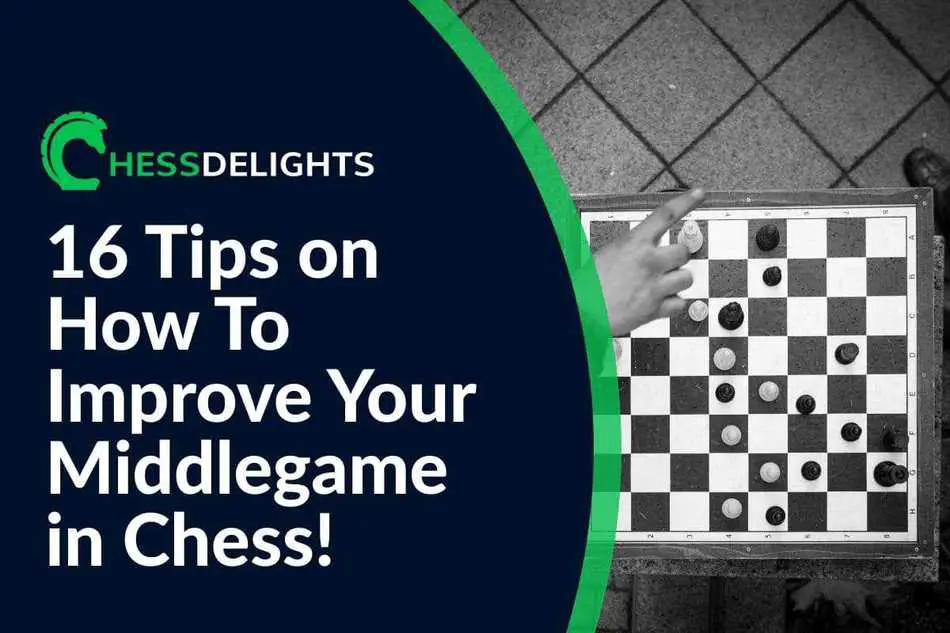If you want to checkmate your opponent in just 4 moves, you should be familiar with the Scholar's mate.
The Scholar's mate is considered one of the quickest ways to checkmate your opponent in just 4 moves beside the Fool's mate. I have encountered this 4 move checkmate several times, and it is a popular option when played as white, but I will also show you some variations I tried when playing as Black.
The key chess pieces of this 4 move checkmate are the Bishop and Queen.
You can follow the same move by going through the Scholar's mate chess notation below:
1. e4 e5 2. Bc4 Nc6 3. Qh5 Nf6 4. Qxf7#
or check the below interactive board
An interesting fact is that when I run the Scholar's mate through Chess.com, it is referred to as King's Pawn Opening: Wayward Queen Attack!

So, if you have a new friend that is playing chess, you can impress them by mentioning the Scholar's mate is also called Wayward Queen Attack. 🙂
The main target of White is the weak f7 pawn of Black.
Table of Contents
How to counter or defend against the 4 move checkmate?
When we are talking about the Scholar's mate or 4 moves checkmate, we can counter it by moving either the Pawn or the Black Queen.
You can block or protect the f7 pawn using the Black Queen, or the Black Knight.
Here are some of the moves you would want to study if you encounter this 4 move checkmate.
- Blocking by Pawn:
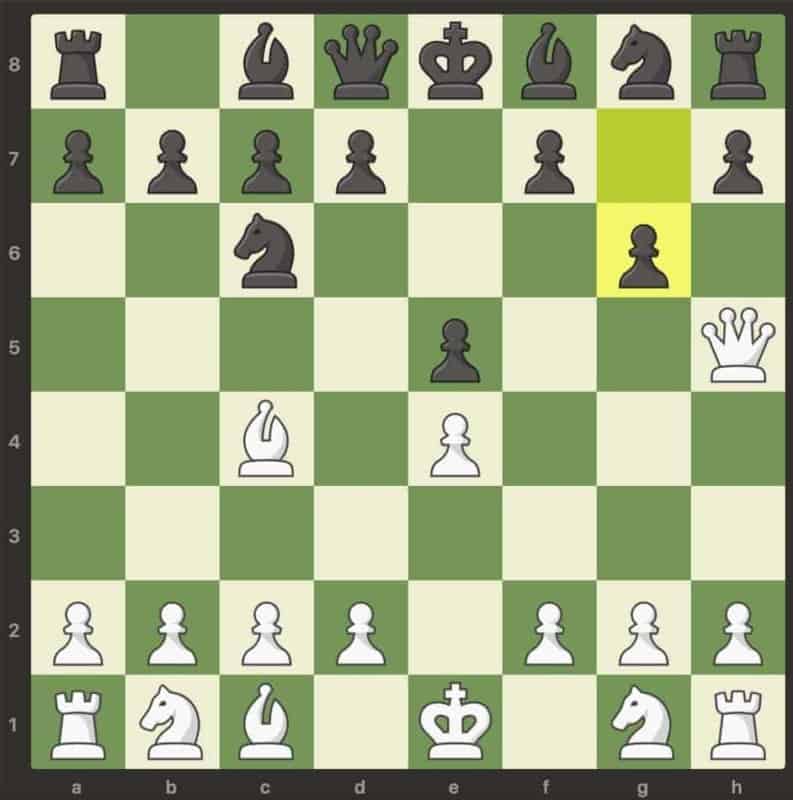
Or
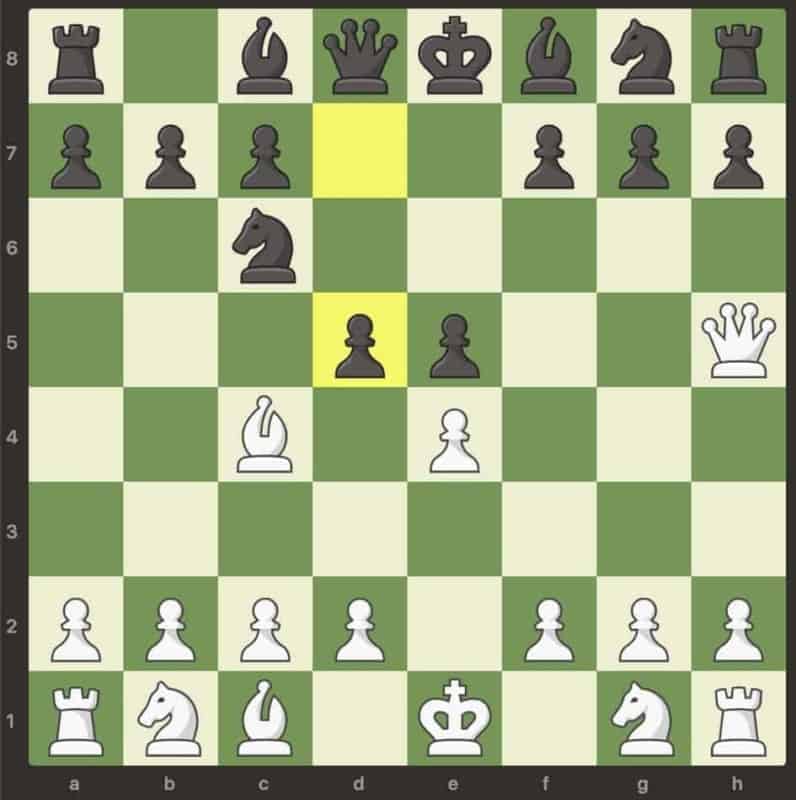
You can Block the checkmate by moving a pawn to g6 or moving a pawn to d5:
2. Protecting the weak f7 pawn.

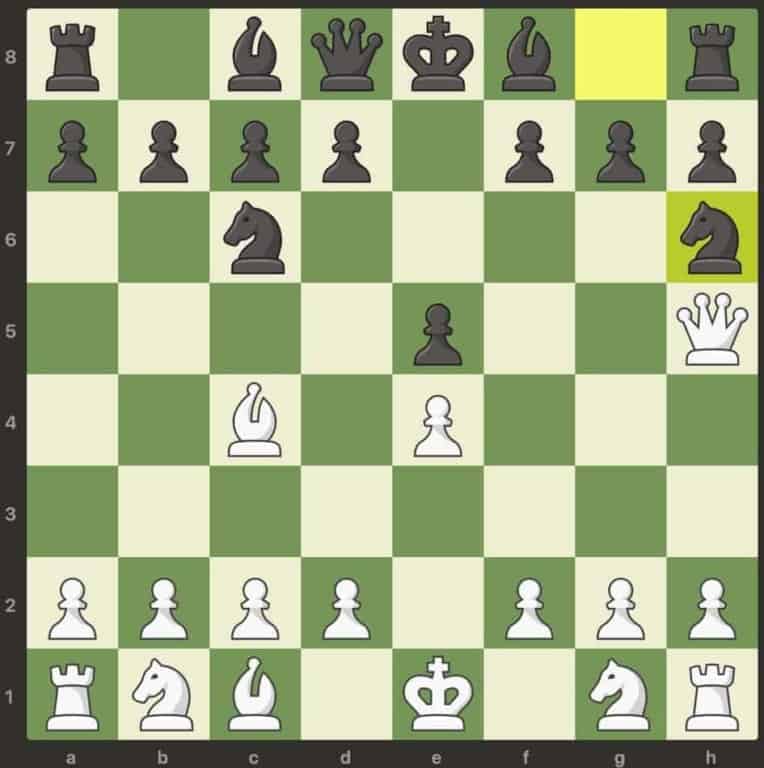
You can protect the weak f7 pawn by moving the Black Queen, or your Black Knight.
If you were to ask me what I prefer to use, I would say I like to move the pawn to g6; after that, the White Queen will generally go back to f3 square, which I will move my Black Knight to f6 square.
Those moves will be enough to neutralize that attack!
Complete Guides: If you want to learn about advanced chess strategies, read this guide.
How can the Black play Scholar's mate?
I have rarely seen the 4 move checkmate being played as Black, but if that will happen, this is how I imagine it would look like! 🙂
1. e4 e5 2. Nc3 Bc5 3. Bc4 Qh4 4. Nf3 Qxf2#
Or check interactive board below:
Or it could look like this;
1. e4 e5 2. Nc3 Bc5 3. d3 Qh4 4. Nf3 Qxf2#
Or checkout the interactive board below:
If you were to play the Scholar's mate as Black, then your main target is the weak f2 pawn on the Kingside!
How can you defend against the Scholar's mate as White?
The same idea can be applied to Black's attempt with the 4 move checkmate. Black can protect or block the attack of the Black Bishop and Black Queen.
- Blocking by pawn:
You can block the attack by moving a pawn to g3 or moving a pawn to d4.
Here is what it's going to look like.
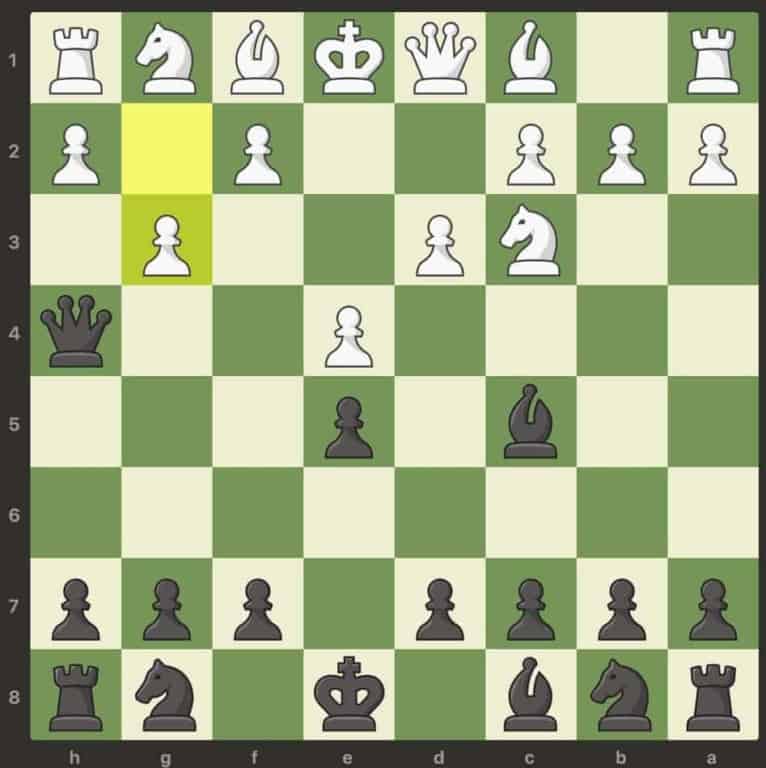

If you don't prefer to use the pawn to defend the attack, you can protect the weak f2 pawn by the White Queen, White Bishop, and White Knight.
2. Protecting the weak f2 pawn:
You can move the White Queen on squares e2 or f3.
Here is what it's going to look like;
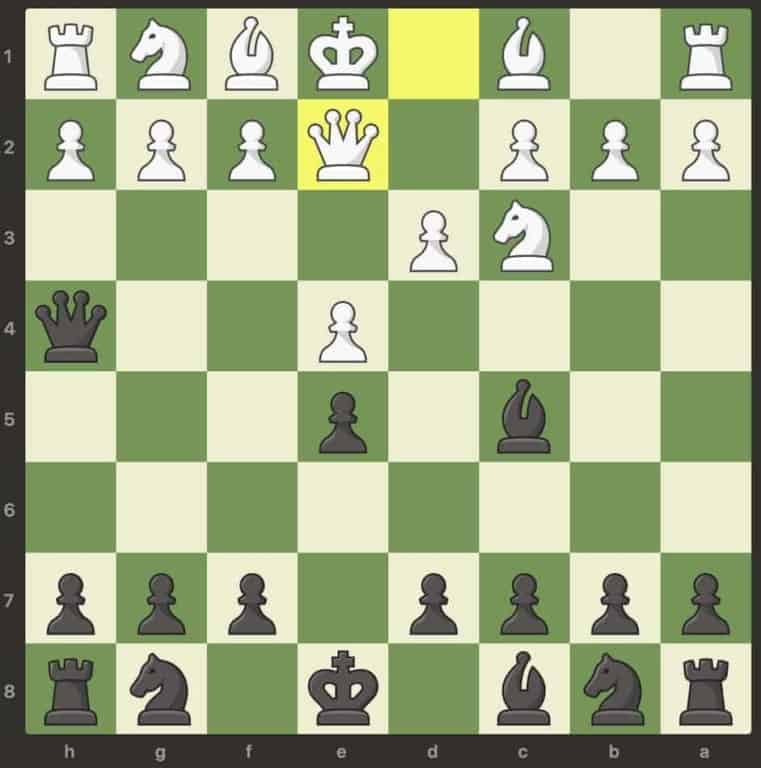
Or
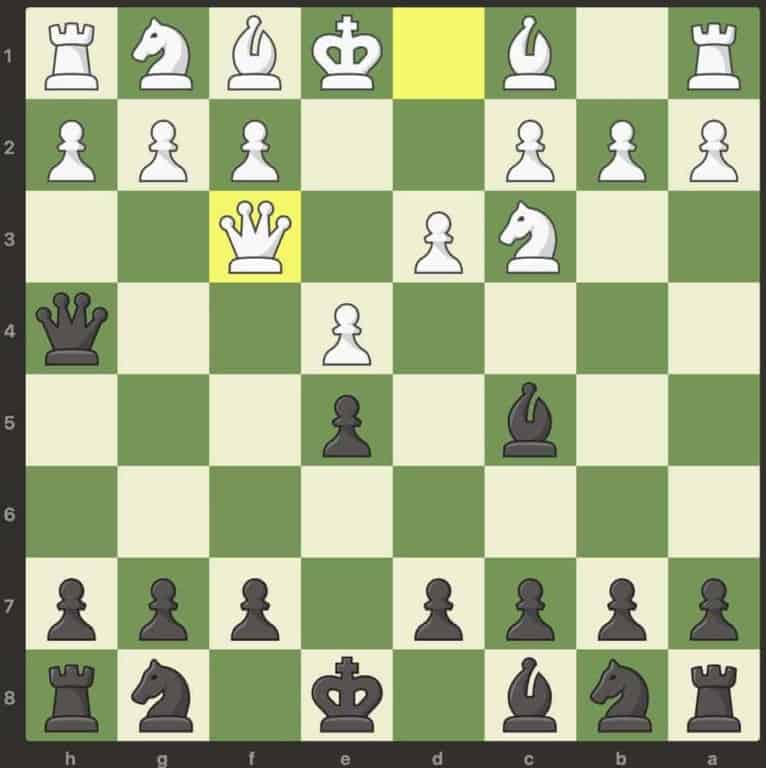
You can move your White Knight to h3.
Here is what it's going to look like;
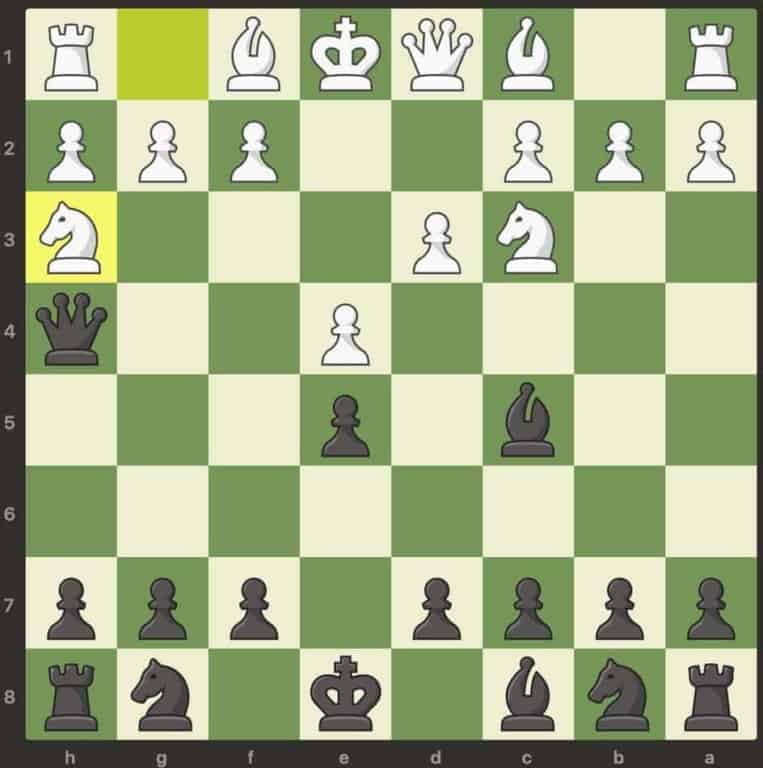
You can use the White Bishop to protect the weak f2 pawn only if the Black Queen is on f6 square. Otherwise, you cannot use the White Bishop to protect the f2 pawn.
Here is what it's going to look like;

That should help you neutralize the attack from Black and start counter-attacking the Black Queen.
If you plan to use this checkmate move against your opponent, you need to identify four types of chess players. This is important; otherwise, you might end up in a losing position.
Other examples of a 4 move checkmate for Black and white you can study
In this section, I will help you look at other 4 move checkmates that you can attempt to use against your opponent. I don't guarantee your chance of winning, but I do like to experiment and play quick checkmates sometimes!
Some of these moves are very unlikely to happen, but we love to look at quick checkmates anyway, right?! 🙂
Examples of 4 move checkmate played as White.
1. e4 e5 2. Qf3 Nc6 3. Bc4 Bc5 4. Qxf7#
1. Nf3 e6 2. Nd4 c5 3. Nb5 Ne7 4. Nd6#
Examples of 4 move checkmate played as Black.
1. e4 e5 2. Nf3 Qf6 3. d3 Bc5 4. Ng5 Qxf2#
1. e4 Nf6 2. e5 Nd5 3. c4 Nb4 4. Ne2 Nd3#
Identify 4 types of chess players to win using 4 moves checkmate.
Now, many of you who learned about this 4 move checkmate would probably attempt to use this to your opponent right away – but it doesn't work like that! You need to know a little bit about your opponent.
In order to increase your chances of winning with the Scholar's mate, your opponent should be;
Baby chess player – someone who is just starting to learn about chess; if you've seen the Netflix Queen's Gambit where the Scholar's mate defeated Beth Harmon, that is what I'm talking about. 🙂
The four move checkmate would typically work with them because they are just baby and don't know about checkmate combinations, and they may only know a few moves at this point.
If you come across a baby player, you can attempt to play the Scholar's mate or any four-move checkmate above.
Few games chess player – someone who has been playing for a little while, maybe 1 or 3 games, and has never played with tough players in your area.
The four move checkmate will work with them because they just have played less game compared to you. And it's more likely that they have not encountered the Scholar's mate.
I would suggest you attempt to play the Scholar's mate with this type of player.
The nervous chess player – someone who is very anxious and maybe a first-time tournament player. I remember joining my first competition, and I was so nervous because there were so many good players around me.
Once you identify that your opponent is a first-time competitor, I would suggest you attempt a 4 move checkmate. It will be easily stopped, but they will be in a tough situation and probably lose a reasonable amount of time in their chess clock.
Low focus chess player – this is someone who is not concentrating on the game, and they will not notice a 4 move checkmate because they are pretty much occupied.
It is seldom you find this type of chess players in tournaments, but you may find these types of player at your own home… 🙂
Your relative or maybe your grandparents and your siblings will be the right candidate for a 4 move checkmate because they are not focused on the game, but they want to appease you in playing chess at home even if they are busy!
Why does Scholar's mate work?
The Scholar's mate works only because of the different types of chess players. You only need to identify if it is the right time to play it against your opponent – that is why I gave some helpful tips above about different types of chess players.
You also need to remember that the Scholar's mate's main target is the weak f7 or f2 pawn. These pawns are weak because the only piece protecting it is the King – and the King cannot do much if attacked with combinations of Queen and Bishop.
Wrapping Up
You should be able to accurately defend yourself from the Scholar's mate after reading this article. It is never advised to play the 4 move checkmate in real tournaments unless you are a World Champion like Magnus Carlsen, who attempted to play the Scholar's mate.
You can watch the video here from Agadmator's chess channel.
If you want to impress your family with this quick checkmate move, you need to play with a low focus chess player – which you can find at your own home…
I have also added the other 4 move checkmates above that you can study if your opponent attempts to use them against you! 🙂
Recommended reading: If you want to learn the fastest checkmate using rook and king, read this article.





